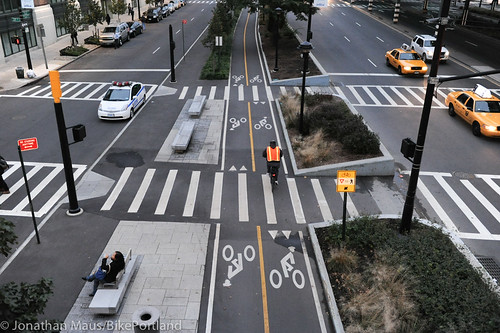
(Photos © J. Maus/BikePortland)
made possible by:
- Planet Bike
- Lancaster Engineering
- Readers like you!
Like some of you, I’ve been hearing and reading about the “streets renaissance” going on in New York City for several years (thanks in large part to the coverage on Streetsblog and Streetfilms). Yesterday I got my first chance to see it for myself.
My impression? It’s even better than I thought.
Thanks to an impromptu tour led by Streetfilms’ Clarence Eckerson (a man whose films I’ve relied on as a window into New York City’s progress for the past six years), I got to see several of the NYC Department of Transportation’s streetscape projects.
As we walked around Manhattan, I saw roadway space being allocated to include bicycle access everywhere I looked: buffered bike lanes; green, curbside bike lanes; physically separated bike lanes; multi-use paths, and more. (And for walking, there were plazas, abundant striped crosswalks, median islands, curb extensions, and more.) And there was a wide mix of people of using the bikeways; from workers on delivery bikes to families to fixed gear daredevils, fashion-conscious women, and more.
When a woman like this feels comfortable biking on one of New York City’s busy intersections with a skateboard in a basket and an iPhone in her hand, you know they’re doing something right…
On 1st and 2nd Avenues (a major north/south couplet), NYCDOT transformed wide, auto-centric streetscapes into streets with “select bus service” where buses have a dedicated, priority lane; and protected bike lanes.
At one point as we crossed a street, Clarence noticed a new, bright-green colored bike lane. “Oh, hey, where’d that come from?!” he exclaimed. It seems they are implementing new bikeways faster than even local activists can keep up.
On nearby Allen Street, NYCDOT has transformed what was once a neglected and narrow center median — between two-way, high-volume, high-speed roads full of cars — into an oasis with protected bike lanes running adjacent to it on both sides.
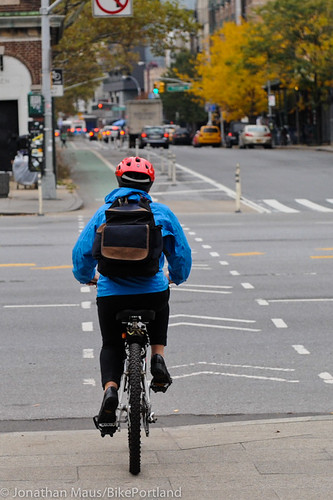
Allen Street was interesting because it shows how NYCDOT is already improving on their improvements. For several blocks the center median has parallel, green-colored bike lanes separated by plastic bollards. Then further north, Clarence showed me the latest evolution of Allen Street. Instead of just the colored bike lanes, NYCDOT has widened the center median and created what reminds me of the Park Blocks in Portland. There’s a walking path in the middle lined with new benches and artwork, and a biking-only path on the outer edge. Public art and lots of newly planted trees and gardens abound.
Heading east, we walked along Delancey Street, a major feeder route onto the Williamsburg Bridge. In one of their very recent intersection makeovers, NYCDOT has created large public spaces smack dab in what used to be travel lanes. Where cars once ruled in the margins of this large arterial, now a group of teens sits on a large boulder, and a woman with two young kids pushes a stroller.
At Clinton Street (near the bridge entrance), newly green-colored, separated bike lanes feed into Delancey up onto the bridge’s biking and walking path (which runs in the center of the bridge).
As a steady stream of people on bikes streamed by us, we just sat there, taking it all in. The intersection was humane, crossing distances were shortened with bulb-outs and generously zebra-striped crosswalks, feeder bikeways from all directions led intuitively up onto the bridge path. It’s not perfect (DOT Commissioner Sadik-Khan is known to “tweak” designs as needed); but it’s a fantastic transformation that should excite anyone who cares about traffic justice and safety.
Continuing over to Queens Plaza North, Clarence pointed out where NYCDOT expanded a narrow, relatively unused sidewalk under the Queensboro Bridge into a two-way. grade-separated cycle-track and walking path.
The path connects directly up onto the bridge, and there are small bike chevrons to let folks know where to ride.
At Crescent Street, the bikeway turns into a dedicated path that runs through what feels like a park. When you stop and think that people are riding and walking in what used to be a huge parking lot, it really is breathtaking.
In just a relatively short walk, I was able to easily see the reality behind all the talk and hype I’ve heard about for the past five years. It surpassed my expectations, and I can’t wait to get out there and see more of it. Stay tuned.
— This post is part of my ongoing New York City coverage. I’m here for a week to cover the NACTO Designing Cities conference and the city’s bike culture in general. This special reporting trip was made possible by Planet Bike, Lancaster Engineering, and by readers like you. Thank you! You can find all my coverage from this trip here.


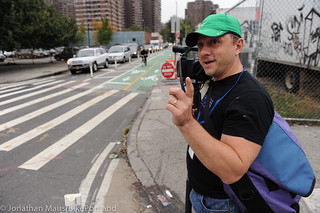

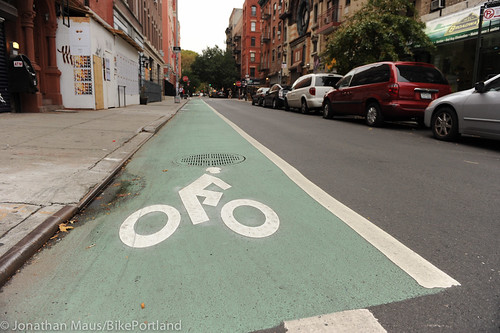
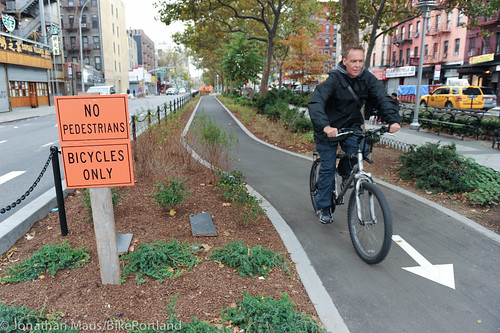
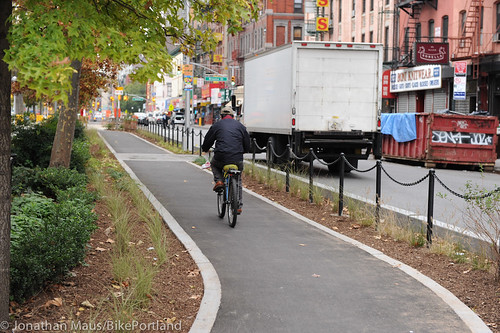

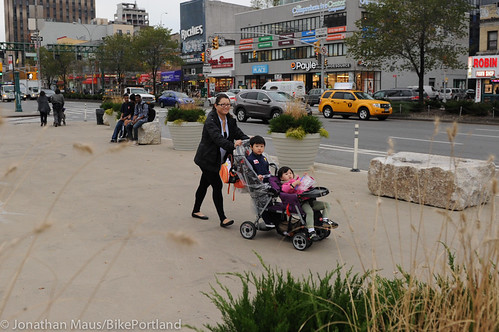
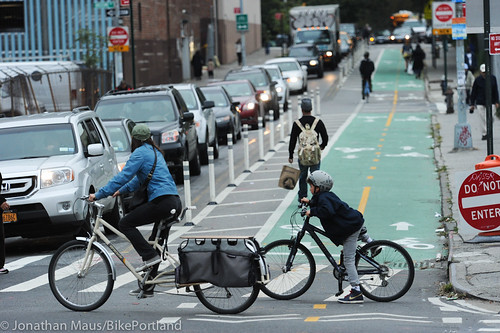
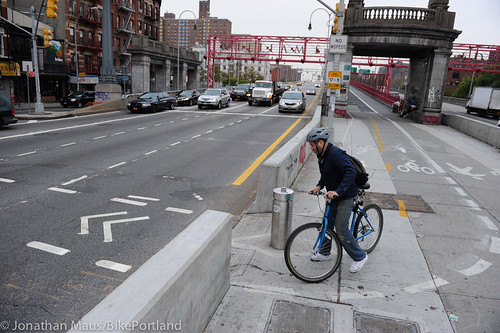

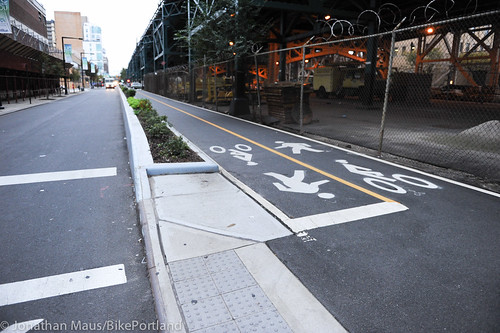
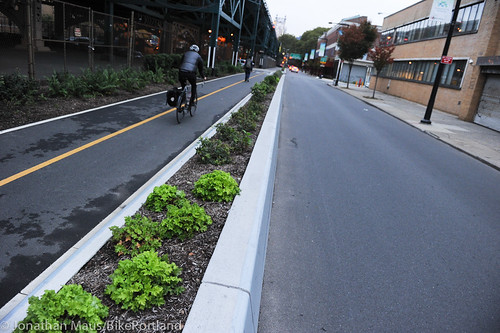
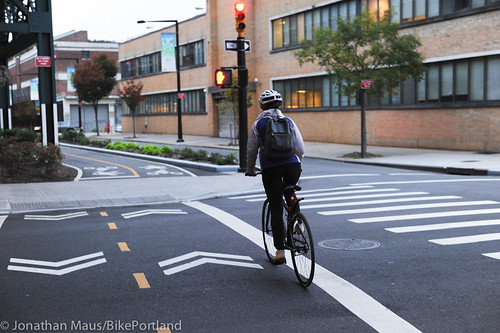
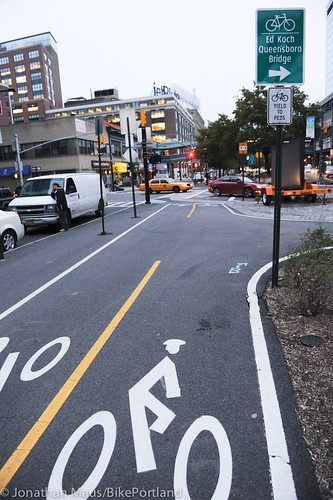
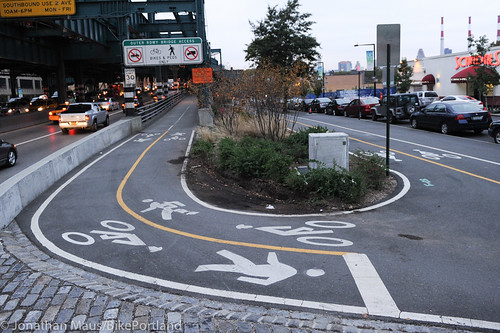
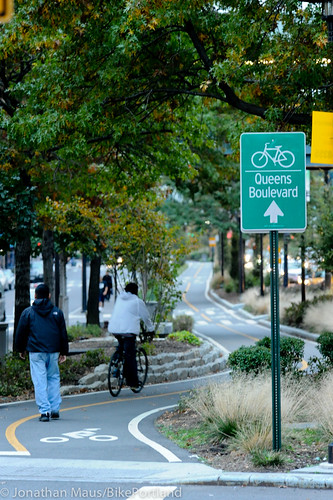
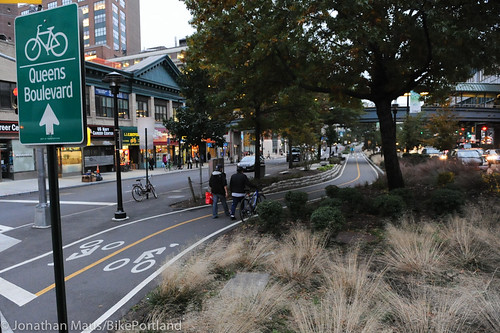

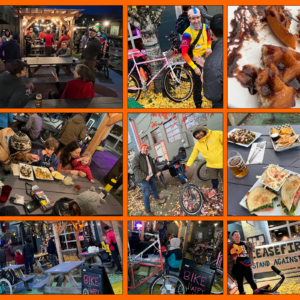


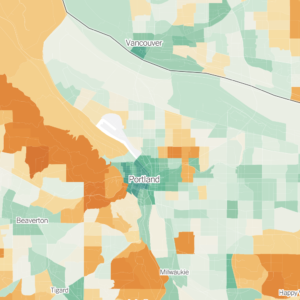
Thanks for reading.
BikePortland has served this community with independent community journalism since 2005. We rely on subscriptions from readers like you to survive. Your financial support is vital in keeping this valuable resource alive and well.
Please subscribe today to strengthen and expand our work.
*drool*
And other wet spots.
Wow, this is impressive.
Having lived in the Northeast, my only lament is that year-round cycling can get difficult there. There are 3-4 months of the year where snow, ice, and extreme temperatures make bike commuting quite difficult.
Snow is rarely a problem in NYC, although it can be in other places. As for the cold, you can do it if you are determined enough, but it’s not pleasant IMHO. 🙂
If you live far uptown actually snow and ice are a big problem. The west side bike paths is by no means sufficiently illuminated above 56th street for riding in darkness, and most commutes take place in darkness. The streets, which are illuminated, typically have a pile of ice sludge post snowfall for anywhere from a few days to a few weeks. Good luck getting even more pavement yielded to you in the dark for six or more miles in each direction every day. If I lived downtown–or even below 125th–it would be a different story. The conditions are vastly better with more on-road lanes and more cyclists.
Wow. The photos are great looking and I’m super jealous. Way to go NYC.
Holy crap, I had no idea! Wow!
Also like the “select-bus service” dedication to mass transit and bike lanes. 5th and 6th avenue, your time is coming. I hope.
Alas, that’s one place that NYC could learn from PDX – light rail and streetcars. The bus lines are far over-capacity, and a light rail train or even a streetcar with dedicated lanes could move even more people. Hopefully the bike lanes will remove some of that overcrowding.
They already have the best subway system in the world – which was built specifically to get street car tracks and train tracks off the city streets. Why in the Heck would they want to go BACKWARDS.
Street cars SUCK for pedestrians and cyclists. Subways are great and fast and don’t get stuck in traffic and don’t clutter up traffic and leave the street safe for other users.
It’s depressing to see how far behind Portland really is. As Jonathan has said before, all the praise Portland gets is actually holding the city back from making the kind of significant bike improvements our city really needs. I can think of one tiny strip along the south waterfront that comes close but Portland needs to quit listening to its own hype and actually invest in making a difference in the quality of cycling infrastructure.
I’m not sure it is the praise that is holding us back as much as what I perceive as an absence of boldness, a clear, bold vision well communicated and swiftly implemented. I’m sure there are a thousand roadblocks to making this happen in Portland, but it is very good to see a working successful contemporary US effort. Maybe this can help us overcome these roadblocks here at home?
In short: leadership. That’s all it takes. And yeah, there’s no reason NYC can’t be a “leader” of other cities like ours.
Clear vision – exactly. I think PBoT is still doing a lot of great work, but what’s needed is bold vision at the top (mayor, city council) and a free hand given to really step up our game. Otherwise, we’ll be recognized for our historical accomplishments (Portland was first, Portland led the way, Portland used to be a contender…) rather than what we are continuing to do. Portland has some great plans, but things aren’t moving as fast nor as far as they need to. I don’t think it’s a lack of will on the part of PBOT, or other polities, I think it’s a lack of folks at the top to remove the obstacles in the way which are slowing everything down.
True. I don’t want Portland to be known for its glorious past. But I’m concerned for the next four years – I don’t know that any member of City Council, current or potential, has the will or grit to take our current transportation network into the next stage of its evolution.
It takes a Sadik-Kahn/Bloomberg partnership to make it happen – innovation and vision with muscle and funding to back it. Will Portland get that this November?
I thought it was the politicians who follow. That it was up to us to lead/demand/insist/hold their feet to the fire.
That’s one strategy…but from the photos, it looks like the top-down approach is plenty successful.
That’s a good point, and in NYC a lot of people are worried that the next administration will not have the same vision. Luckily, by that time we’ll have bike share and hopefully a lot more protected lanes, so a lot more people will be biking than right now.
A Deputy Commissioner at NYC DOT brought this issue up in a panel discussion this afternoon… And they’re already thinking ahead to the next administration. One way they plan to assure the changes continue is by aggressively documenting the positive impacts these changes are causing through a variety of metrics. They have already released their first major report and the findings were very very positive. Sales are up, traffic volumes are up, safety is up.
Don’t forget, Portland has a “weak mayor” system of governance that prevents strong leadership. Also, none of our candidates are that interested in bikes. Maybe in a hundred years!
NYC has tons more money than Portland, part of the reason it can make these kinds of infrastructure transformations while cities such as Portland and its suburbs are obliged to address the more basic priority of maintaining motor vehicle travel that our areas’ land use planning relies upon.
Available right-of-way, speed limits and minimum required traffic flow volumes are issues too. In Portland, West Burnside street has been…is still being considered for alterations with the objective of it becoming more of a walkable-bikeable street, but with the very high motor vehicle traffic obligations it’s held to, efforts to come up with redesign ideas approaching the level of some of this story’s featured NYC streets, are yet to be successful.
and curb to curb measurements on some of the stuff you are showing in these photos are entirely beyond anything you can retrofit here in portland. so yes, grab some of the ideas, but then try to figure out how they can be scaled to the available space. one of the only places in portland in which you could create (for example) these glorious central parkway alignments would be in the park blocks where (a) they are not needed and (b) you would be subtracting from pedestrian rather than motorist space.
There are plenty of 7-lane 80 foot wide streets in this city that are just begging to be revamped. Those are the places these designs should go.
Also, if we’re willing to go to single lane in each direction on our inner arterials, we’ll have more room to work with.
i agree, nick, but again this is a matter of scaling. we are looking at photos here of rights of way well in excess of eighty feet. the headline photo looks like it might be almost twice that.
It is very wide there (in the headline photo at Queens Blvd) What is missing from the picture is the context of what a complete traffic nightmare that area is/was before. There are multiple 8 or 10 lane roads running through there (here is a link https://maps.google.com/maps?q=Queens+Plaza,+New+York,+NY&hl=en&ll=40.749663,-73.937774&spn=0.017621,0.033689&sll=44.145447,-120.583402&sspn=4.272993,8.624268&oq=Queens+Plaz&t=h&hnear=Queens+Plaza&z=15) Roughly I’d estimate this is like squeezing about 50% of all the traffic in the PDX downtown core into just the old/town area. You’ve got the Queensborough bridge witch might nearly equal all the non-interstate bridges in PDX combined for traffic and all that traffic is squeezing through a triangle of land sandwiched between the river and the railroad yard on a street grid that has been in place since the 19th century.
So what you see there looks like they had a LOT of room to work with which is true in the absolute sense. But in the relative sense they removed a lot of lanes and reconfigured a lot of road space. It would be interesting to see some before pictures.
On the other hand part of why they were able to do this was that was a neighborhood that was really in need of renewal. There wasn’t much room to gripe about hurting businesses or property values.
If you think of big arterials like Barbur Blvd, Beaverton-Hillsdale Hwy, Powell and Sandy, there is ample of room to add cycletracks and sidewalks if we were willing (and find the money). Downtown streets probably would have to be converted to bike/pedestrian streets entirely because they are narrower. All European cities, even small towns have pedestrian zones in the downtown cores.
“If you think of big arterials like Barbur Blvd, Beaverton-Hillsdale Hwy, Powell and Sandy, there is ample of room to add cycletracks and sidewalks… .” Barbara
True that there are streets and roads in the metro area with the width of some of the wider streets shown in the picture accompanying this story. As I noted in my post, minimum required traffic flow volumes are issues too.
So while a street such as Beav-Hillsdale…parts of which run close to areas potentially favorable to non-motorized travel…is a miserable, traffic choked quagmire that with certain changes really could be a far more friendly piece of infrastructure, it’s a bit of a solitary example serving that area. As such, apparently it’s obliged to move the amount of motor vehicle traffic it does, because options in the form of other similar sized nearby streets upon which some of the traffic volume might be distributed to, don’t exist.
More specifically how NYC was able to manage and/or sustain vehicle flow service levels in the areas of the projects depicted, using neighboring streets, and whether NYC’s ideas could work to some extent for big thoroughfares in Portland such as Powell, Foster, maybe Hawthorne, or the Watson/Hall couplet out in the Beav, are questions occurring to me.
Also more density, making non-auto trips much quicker.
is that based on actual data? because having worked in financial management for the city of new york, I can tell you that many of the city agencies are running quite a deficit, and times in NYC are just as tough as they are in PDX. For every dollar that NYC residents pay in federal taxes, they get $0.30 back in improvements. NYC subsidizes upstate NY, as well as the rest of the country.
CW
I get your point. I don’t often agree with WSBob. However, in absolute terms, certainly the NYC budget for roads dwarfs the PDX budget. You are right that it doesn’t mean NYC has buckets of available $$$ for whimsical projects. PDXers would be really horrified by the conditions of roads NYC in general especially outside of Manhattan.
The Bloomberg administration has recognized that it is cheaper and saves money in the long run to get people on bikes and out of cars. In Manhattan and the inner boroughs adding or improving infrastructure to increase auto traffic is clearly a losing proposition for the city financially. Every dollar the spend increases future maintenance cost and the cost of adding capacity for either parking or traffic volume is far higher than the cost of adding bicycle capacity.
In fact, here is where WSBOB is correct. In NYC the savings in maintenance from removing lanes and decreasing auto-capacity will actually more than offset the cost of dedicated bicycle infrastructure. This differential is more obvious and is significantly larger in NYC than in PDX or other much less dense cities.
“In NYC the savings in maintenance from removing lanes and decreasing auto-capacity will actually more than offset the cost of dedicated bicycle infrastructure.”
And there are more, dynamic ways of looking at this too. Bike infrastructure as we understand it is for the most part necessitated by the overwhelming presence of the auto. As that overwhelming presence is discouraged, atrophies the whole calculus starts to shift. One day we’ll wake up and realize that with the car shrunk to a minor presence most of our maintenance costs, not to mention freeway expansion costs, also disappeared, and with them the need for a parallel infrastructure. Sure it may be a few years off, but why not call a spade a spade?
“…However, in absolute terms, certainly the NYC budget for roads dwarfs the PDX budget. You are right that it doesn’t mean NYC has buckets of available $$$ for whimsical projects. PDXers would be really horrified by the conditions of roads NYC in general especially outside of Manhattan. …” Paul in the ‘couve
More people, living closer together, providing a much bigger tax base to cover infrastructure costs. This is a city that has built and maintains an extensive subway system, just one example of how important efficient transportation is considered to be in NYC. From its early years, the city was able to do so because, relative to the rest of the U.S, Manhattan is the financial center of the universe. Being what it is, Manhattan is naturally in line to get the cream of the crop, just as in Portland, Downtown tends to get the same while year after year, its outlying neighborhoods go lacking.
The type of big infrastructure changes in NYC, featured in this story aren’t ‘whimsical’, at least not exclusively so, but they are of an unconventional nature and of an engineering challenge that likely would have officials in the metro area hesitant to seriously consider taking some of them on here.
I actually totally agree with you wsbob. The only point I was attempting to have common ground with cw regarding is that NYC, especially in this economy, also has many competing priorities for its road (and general fund) budgets. The number or roads that have outdated designs, inefficient 40 or 50 year old signals, all kinds of hazards with overhead train line supports, broken pavement, broken sidewalks etc. etc. in the whole NYC boundaries is absolutely staggering compared to the issues in PDX. CW is correct that it isn’t as if NYC DOT isn’t making tough decisions in building bike infrastructure and that every $ spent on cycling could easily be spent just filling pot holes.
However, beyond that, I totally agree with you about density, ability to finance, etc.
“…The number or roads that have outdated designs, inefficient 40 or 50 year old signals, all kinds of hazards with overhead train line supports, broken pavement, broken sidewalks etc. etc. in the whole NYC boundaries is absolutely staggering compared to the issues in PDX. CW is correct that it isn’t as if NYC DOT isn’t making tough decisions in building bike infrastructure and that every $ spent on cycling could easily be spent just filling pot holes. …” Paul in the ‘couve
I think all of this is true. Being a comparatively far more intense city for living and doing business than is Portland, NYC had to make the kinds of changes it has in Manhattan. Before having made them, this core part of the city was gradually spiraling down into a hopeless mire of motor vehicle traffic. The changes supporting walking, biking, and just day to day living outside the car, help enable the city to continue being a viable place to live.
People aren’t going to walk or bike where the experience has been allowed to be atrocious through domination of the street by motor vehicles. Even while it seems to me, likely that motor vehicles will continue to be an integral part of in-city, neighborhood to town transportation, increases in the development of inviting walkable and bike-able infrastructure, are essential to continued viability of living areas. As an example using my area, Beaverton, actually putting things together to enable such changes to be made is a very big challenge.
Portland is a great biking city, by American standards, not because our infrastructure is so outstanding, but because a lot of people bike. Think how many more people we could get on bikes in the infrastructure was better.
Wow…this puts Portland to shame!
Let’s make this happen!
I agree…it has been an amazing progress to see how NYC bikeways have evolved in the last 10 years (as I revisit same neighborhoods every 3 years) and in light of my memories of the City in the 70s/ 80s too.
I rode on Allen St, etc. and agree with Jonathan – interesting to see the transition from low cost near term facilities to long term (multigenerational) facilities.
Though i am hearing from local staff: that commercial retail/ entertainment gentrification (car parking from bridge and tunbel types) may be threatening some efforts.
I was amazed during our visit to NYC last Spring. The transformation of streets into parks at major crisscrossing intersections was everywhere. Many, many tables and chairs, planters, dividers. The renovation of Grant park was also amazing. This whole initiative is awesome, and Paris like. Then again, NYC is so expensive they may have many, many more resources they can bring to bare. How can this help PDX identify better projects? My mind thinks the central core is key, and the Park Blocks may be the best next street closures turned to multi-use pedestrian/bikes.
Sorry, Bryant park. http://www.bryantpark.org/
wow. Very impressive. I absolutely love those dedicated bikeways and I want to see more of them here.
I think one near term strategy we should all participate in here is the bike community needs to “pounce” the moment our new mayor is sworn in. We need to set a precedent immediately to whomever that ends up being that the biking and walking community will not just sit idle and wait for our mayor to “get around to” improvements. Our safety is not something we will accept being placed on the back burner.
Naturally we don’t want to be rude, nor do we want to come across as militant, but we can and we should be stern.
I encourage everyone out there to send a letter to our new mayor (both in e-mail and physical form) within 30 days of said person taking office.
I wanta ride there someday.. west coast dude here aka left coaster ;-P
awesome reporting BTW
Biking in NYC is great and getting better – rather biking in Manhattan and inner Brooklyn is great. Queens has some OK spots and the Queens plaza is great addition, and there is a lot of potential in Queens. I’d missed Allen street so far, I’ll have to check it out next trip.
The part that is easy to miss is that Brooklyn, Queens and the Bronx are all pretty big places. Only a small fraction of each has this kind of cycling infrastructure. The outer neighborhoods are complaining (mostly without much attention) that they are being neglected in this renewal and they are right. I have riden east/west across both Brooklyn and Queens several times and there are far more places where cycling is difficult than where there is new great infrastructure.
It isn’t that there aren’t connections are some really nice areas, streets, and even bike lanes. Actually in that respect Queens and Brooklyn are ahead of outer areas in Portland that with the density and the old street grid and narrow streets almost all of the little neighborhoods are reasonably bike-able.
The problems come when cyclists want to make longer trips. There are very few routes that go through reasonably straight. Nearly all of those routes are heavily traveled high speed streets with no infrastructure for cyclists. It is more doable than one would think. I find other cyclists that are surprised I’ve made the trip.
Of course, there is always the subway… but there are limitations there too.
Anyway, cycling in Manhattan, and Williamsburg and Red Hook is great, and even better than PDX. I was surprised this past summer when I made my first journey to Long Island City Queens in several years. It has been almost completely transformed from light industrial and body shop into essentially a Super Sized PDX Pearl neighborhood.
Have Fun Jonathan.
“…Only a small fraction of each has this kind of cycling infrastructure. …” Paul in the ‘couve
Good point. It’s great that NYC is making these kinds of improvements, but being able to make them shouldn’t be assumed to be an easy undertaking.
I second the words about long trips in NYC.
Yes, commuting is much more inviting than it was just a couple of years ago in much of Manhattan, much of Brooklyn, and the LIC/Astoria section of Queens. IMO, cycling in PDX remains much more comfortable and low-key compared to anywhere here.
I have noticed that each time I visit Brooklyn that it seems easier and easier, rivaling PDX.
Drivers here are much more aggressive, and that is increasingly the biggest difference — less and less are the big differences coming down to infrastructure.
I have mixed feelings about Allen St. It’s great but it’s shifted conflict from driver-cyclist/ped to cyclist-ped because many of the intersections don’t feel like intersections. I try to be very cognizant of peds but there are a couple of intersections that don’t feel like intersections because of the wide median park. They could solve this with slightly different treatments where the crosswalks cross the median.
I have to admit that having gone back to visit and bike in Seattle and PDX last year and returned a bit jealous, it’s gratifying to read that Jonathan might be a little envious of NYC.
Completely agree with the leadership and vision thing. All hail Sadik-Khan! I wonder if another contributor in this particular locale is the relatively high percentage of the population who aren’t drivers? Many folks in NYC don’t even own cars or even driver’s licenses, so maybe don’t object to the improvements. In fact they may be more open to it, already accustomed to using alternate forms of transportation, and see potential benefit for themselves here. Could apply to business owners too, who don’t see improved bike infrastructure as impediments to their livelihood since many of their customers arrive by modes other than car already.
Ack. I wish I’d seen the article following this one before posting my response here. Anyway I still stand behind the first two sentences!
That’s been pretty much my experience when I revisit my family’s hometown. Outer Queens and the Bronx can be pretty sketch. Williamsburg and Greenpoint are great.
Jamaica Bay area southern Queens eastern Brooklyn 🙁 not fun. Myrtle ave and metropolitan – some good stretches but mostly a very sketchy ride. The whole chunk of map in the middle of Brooklyn/ Queens with the cemeteries is problematic for me. There are safe routes through there, but linking them together to get where I want to go makes for a zig-zagging route. Trying to take Myrtle, Metropolitan or Atlantic are all seriously un-fun.
Worst ride ever was trying to ride to and on the Jamaica Bay Path to get from Valley Stream to Coney Island. The path was decrepit. Totally not worth going out of my way to get to. So much of those areas seem totally unconnected to what is going on in Williamsburg or Manhattan.
How many parked cars in bike lanes have you counted so far?
wonderful cycling infrastructure juxtaposed with what seems to be a inconsequential value placed on cyclists lives? oh wait… thats not just in nyc.
http://gothamist.com/2011/10/27/driver_who_killed_cyclist_gets_ten.php
http://www.streetsblog.org/2012/05/30/judge-clears-unlicensed-driver-who-left-doored-cyclist-to-die-in-the-street/
http://gothamist.com/2011/10/24/no_charges_against_truck_driver_who.php
http://knowledgebase.findlaw.com/kb/2011/Dec/421683.html
seems nobody cares if folks get run over & killed as long as there is a nice path to ride on egh????
I follow that/ those stories pretty closely. The police force is NOT on the same page as the mayors office. It’s pretty pathetic story. Truth is it’s the same here, cops and the public and the prosecutors just keep the pretense of doing something up a bit longer.
Image where we might be if Sam had put someone with vision in charge at PBOT when he became Trans Commisioner in 2004. A lost opportunity if there ever was one. And don’t forget the mode split in NYC, especially Manhattan…way more peds, way more transit riders. Motorist don’t rule there like they still do here.
Just rode NE Multnomah…trying to figure out what PBOT is doing there. Put that up against the new stuff in NYC; will we still look bush league? I hope not.
Don’t forget that NYC just got started a few years ago. Copenhagen has worked on their system for 30 years and is still improving and expanding!
Fantastic tour with great pictures! I live and bike in New York but I only know a fraction of the facilities you show. The DOT should have something like this in the part of their website about cycling. It really brings to life what they’ve done in a way that a bike lane map can’t.
This, ladies and gentlemen, is how it is done and done correctly. Key word:DONE Not “visioned”, “planned”, “studied”, etc…
Great job, JM, but did you see any fashion-conscious women who ALSO are fixed-gear daredevils?
Powell Blvd west of 205, and the vision for Powell east of 205, seem like good opportunities to transform, or create, a median with a two-way bikeway. Portland’s first bike highway.
I note the almost complete absence of parked car ‘buffers’, and, in fact, the almost complete absence of parked cars on most of these ‘transformed’ arterials.
That’s an interesting point, and these photos only represent a small fraction of what’s been done in NYC. The overwhelming majority of protected bike lanes use parked cars for protection, using this basic configuration of parked cars, green painted lanes, and planted pedestrian refuge islands shown in the link (used on 1st Ave, 2nd Ave, 8th Ave, 9th Ave, Broadway, & Columbus Ave):
http://goo.gl/maps/9mSFT
Here is the 2-way version of it on Prospect Park West in Brooklyn (the painted islands have since been built out with concrete):
http://goo.gl/maps/fVNu3
wow that is bikantastic!
We should demand no less here.
I have a grandparent from the Bronx, another from Brooklyn, one from Manhattan and and the other from Queens. Last summer I biked from my mom’s old neighborhood in Queens and the change, even since I lived on the East Coast just six years ago, is amazing. I also drove, took transit and rode in cabs. New York’s greatest victory is that bikes are often the cheapest, fastest, least stressful way across town.
I’d argue a Portland bike trip is, on average, far less hairy from your front door to your final destination but this is more an accident of topography and neighborhood design. We should consider New York a tough competitor.
Also, don’t get demoralized if drivers scream at you. They scream at everyone in New York. And NY bike politics is a bonfire but all politics in New York are a bonfire. We’re just more laid back here (or passive aggressive, if you’re a cynic).
Someone call Bikesnob! NYC is the new PDX! The irony runs too thick.
The next time someone comes on some bicycle forum, asking, “what tire should I buy? The roads in new york are terrible”
I will just ignore them!
Janette Sadik-Khan, NYC’s fantastic DOT commissioner, will probably be out of a job when Mayor Bloomberg’s term is over. So any city that wants to see real change should make her an offer. And in case you’re worried about drivers not liking her, here’s a piece from a supporter who writes for a right-wing local paper:
http://observer.com/2011/09/road-warrior-janette-sadik-khan-is-the-best-mechanic-the-city-streets-have-had-in-a-generation-so-why-do-motorists-dislike-her-so-much/
Even I’m impressed, and I don’t even own a bicycle
Just to give credit where it’s due, while NYCDOT implemented the “short-term” bike lanes and wider median on Allen (and Pike) Street, the Parks Department is the one actually building them out permanently. Also, the Queens Plaza improvements were built by the NYC Economic Development Corporation, not DOT.